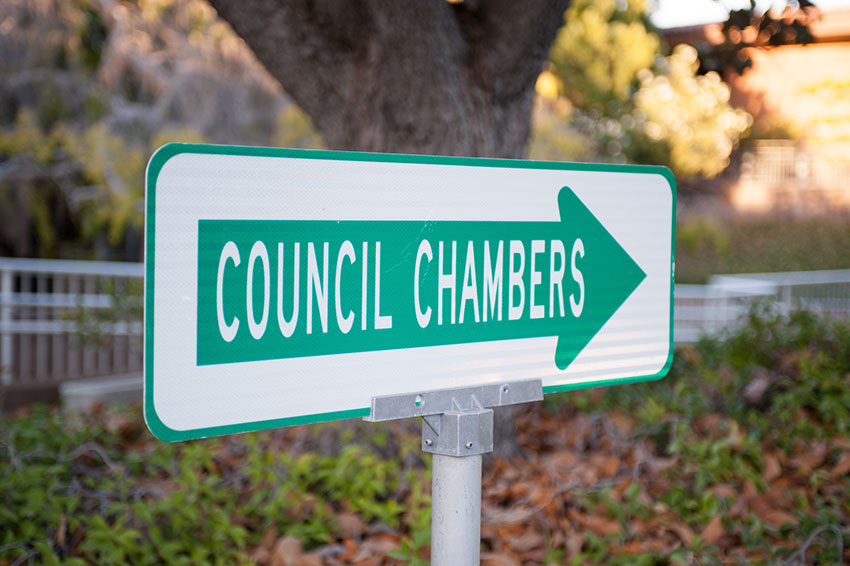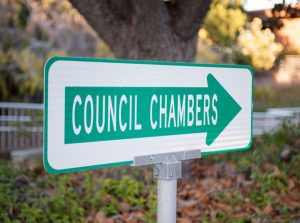The lack of a contract with a public relations firm—and whether Mayor Lisa Gillmor used that firm on her crusade to control the public narrative regarding strife between the 49ers and the City—has galvanized the Santa Clara City Council.
The contract in question, with DC-based Banner Public Affairs, came up during a routine discussion of Stadium Authority financials at Tuesday night’s Council meeting. However, the discussion quickly escalated into finger-pointing with Mayor Gillmor accusing Vice Mayor Dominic Caserta and Council Member Patricia Mahan of “taking thousands of dollars from the 49ers” and Caserta sniping back, calling Gillmor’s claim “blatant lying.”
Caserta railed against the notion that, as the invoice specifies, Gillmor would have used the $450-an-hour consultant to help her draft an op-ed piece that appeared in The San Francisco Chronicle and coach her for a TV interview. He said he was blindsided by the contract, saying he would “never ever, ever bill our taxpayers” for such activities.
“I have never once had an outside consultant or vendor … not reach out to every Council Member,” he said. “It is shocking to me. It is unparalleled.”
“This is not transparent,” he later added. “This is in a back room.”
Gillmor denied having used Banner to draft the op-ed. The situation, Caserta said, is contributing to the “factionalism” on the Council.
The discussion started innocuously enough with Angie Kraetsch, the City’s finance director, presenting the Levi’s Stadium finances, which sought “additional appropriations” from the Stadium Authority’s discretionary fund to the tune of $875,000; a little more than $100,000 of that money was to cover work already done by Banner and possible future work—work done without a contract—and to secure a contract through a new request-for-proposal bid process.
Banner’s fee was nearly double that of the lowest bidder.
City Manager Deanna Santana was content to place responsibility for the problem on former City Manager Rajeev Batra, who authorized the work. The City Manager has the authority to use an “informal process” in selecting a contractor so long as the contract does not exceed $250,000, she said. Batra executed the agreement during a time when he was working in a limited capacity and Jennifer Yamaguma, the City’s public information officer, was on leave, something Santana claimed exacerbated the problem.
Yamaguma did not attend the Council meeting and couldn’t provide any clarification on email exchanges between herself and Banner. However, the email exchanges show that Yamaguma inquired about information the City would need from Banner in order to codify a contract, indicating she was aware of the discrepancy and tried to rectify it.
That Banner was allowed to provide services for the Stadium Authority when it was only authorized to handle Council matters, doing so without a contract for two-and-a-half months, City employees not understanding what services the company was providing and City employees not reconciling payment sooner were all “problematic,” Santana said.
“We have lost our grip on due diligence, and it shows,” she said.
Making matters worse, Caserta challenged whether meetings with Banner were logged properly on the Council calendars as per a City ordinance that requires Council Members to track with whom they meet.
Other Council Members came to the Mayor’s defense.
Council Member Teresa O’Neill said the Mayor is the “primary spokesperson for the City,” so her use of Banner’s services is justified. Meanwhile, Council Member Debi Davis agreed, saying the Mayor needs help “getting the right narrative out there.”
“I don’t see any wrongdoing here. I see this as a personal attack on the Mayor,” Davis said. “It is disgusting. It is a waste of our time. Stop the garbage. I am really sick of it.”
Davis also called media reports—presumably articles published in The Weekly and the Mercury News—about the situation “garbage,” claiming such reports were “laced with inaccuracies.” While she said there is “too much rhetoric out there,” Davis did not point to any specific inaccuracy.
Members of the public also came to Gillmor’s defense. Several Council mainstays had choice words for Caserta and Mahan.
Deborah Bress called their taking issue with the Mayor’s use of Banner’s services “Kabuki theatre,” agreeing with the notion that the City should have a single spokesperson and calling Caserta “Deputy Do-Right.”
Hosam Haggag accused Mahan and Caserta of “double standards and hypocrisy” because of Caserta’s comments expressing chagrin at being unable to speak with Yamaguma about the exchanges, saying that by Caserta’s own logic on the calendaring ordinance he would be unable to do so, instead having to go through Santana. He called criticisms of the Mayor “backstabbing” and accused Mahan and Caserta of “self aggrandizement.”
Caserta retorted, challenging the notion that criticism of the Mayor constitutes harassment, saying that the country was founded on the idea of lively debate.
“Shame on you,” he told his critics.
Gillmor even came to her own defense, saying that Mahan and Caserta “prefer we don’t question the team [the 49ers]. They prefer we don’t have professional communicators.”
Davis refused Caserta’s request to split the motion to approve the appropriations and note and file Stadium Authority financial status report into multiple motions. The motion still passed 6-1, with Caserta voting “no.” Mahan expressed concern over the Banner appropriation, and City Attorney Brian Doyle said he and Santana would review the specifics of what kind of services Banner has provided and clarify this before finalizing the contract.
Developments Ask for Rezoning
Rezoning two developments to planned development also generated much discussion.
The owner of 1075 Pomeroy Ave., Daryoush Marharnat, asked the Council to rezone his 12,400-square-foot building from low-density to planned development to accommodate splitting the building into four separate townhomes.
Andrew Crabtree, Director of Community Development, said the rezoning is consistent with the General Plan, adding that the new building’s “mass and design” and “style and scale” are consistent with the existing neighborhood, two Eichler townhouse developments that are the only examples of Eichler architecture in Santa Clara.
The development would put $109,000 into the City’s coffers in park fees and add another $30,000 to the school district.
Leonard Pecheco, who spoke to the Council on Marharnat’s behalf, said the planned development would add to the City’s housing stock.
However, 14 neighbors turned out to oppose the Council giving the four-unit option the green light.
Ken Kratz, who lives in the adjacent Pomeroy Green, said 178 of the neighbors signed a petition in opposition of the rezoning.
“The proposed development is not compatible with single-family homes,” he said, adding that it would be “jammed in.”
Several members of the group said the rezoning would “set a dangerous precedent.” Many also expressed concern not only with parking but with the idea that—since the four units would have its own homeowners’ association—many people would use their garages for something other than parking—extra rooms, workshops, storage—and that a homeowners association in such a small development would be unlikely to enforce CC&Rs prohibiting other use of garages.
Documents issued by Crabtree and City Manager Santana specify that garages are not to be used for anything other than parking.
“You can’t force someone to use their garage for parking,” said Deborah Bress. “It is called freedom. We still live in America.”
Although the Planning Commission recommended approving the project, Diane Harrison, a Pomeroy Green resident, said the Planning Commission has a bias toward homeownership and against renters.
The group offered other designs for the development and offered to work with the developer to find an amenable solution.
Vice Mayor Caserta said the issue is a “balancing act,” saying he is certain that there is a solution that accommodates the property owner’s rights with the “heritage” of the neighborhood.
Council Member Mahan said she didn’t want to “wreck our Eichler neighborhoods.”
“I just don’t think it’s suitable,” she said.
Homes designed by Joseph Eichler—a mid-20th century designer who popularized “mid-century modern” subdivision-style housing in post-war California—often qualify for historic designations. Although the homes in question are not listed on the City’s historic homes register, Mahan made a motion to refer the item to the Historic Landmarks Commission to look into whether the development is in keeping with the neighborhood’s history and bring the item back to the Council.
The motion passed unanimously.
The Irvine Company also sought the Council’s permission to add 40 apartments to its mixed-used development at 2600 Augustine Dr.
Irvine representative Carlene Matchniff said Irvine wants to add space for a leasing center and 40 new apartments in the 1,800-unit complex by removing the development’s fifth swimming pool. She said the company has established the pool would be underused and the change would free up space while providing amenity space of a different sort elsewhere in the development.
Crabtree said the addition of the 40 apartments, which would also add four “affordable” apartments, would not bump the development’s density into another category from its original design.
The small change was met with little to no resistance, and the Council approved it unanimously.
New Cultural Commissioner
The Council also appointed a new Cultural Commissioner. Following Commissioner Eversley Forte’s resignation, the Council has appointed Candida Diaz to the Cultural Commission. Diaz was selected over eight other applicants for the position. She will serve the remainder of Forte’s term, who had served on the Commission since 2012. That term ends June 30, 2020.
Council Member Pat Kolstad was absent.
The City Council will meet again 7 p.m. Dec. 5 in the Council Chambers at City Hall, 1500 Warburton Ave. in Santa Clara.












0 comments